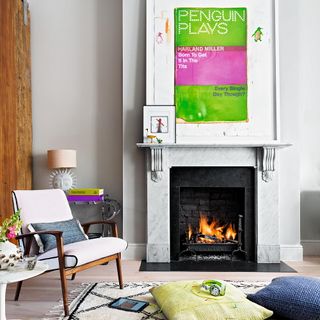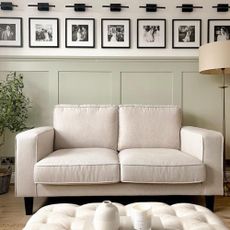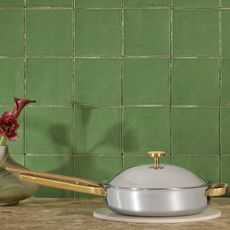Buying a fireplace – how to choose your mantel, fire or stove
Are you buying a fireplace? Use our essential guide to buying fires and fireplaces to make the right choice for your home.

Buying a fireplace can be a tricky decision and one you hope will last for years to come. That's why we've put together our guide to choosing the right fire for your home.
Before fitting a fireplace you'll need professional advice regarding heat output, fuel sources and installation. Most reputable fireplace showrooms offer an installation service, or can recommend registered fitters and installers in the local area. You might also want to research a few fireplace ideas for inspiration.
The fire surround size is important. Too big and it will overpower the room. And if it's too small and it will look insignificant. The size of the existing opening, chimney breast and flue will influence the size of fire and surround that will be suitable for the room. If possible, it may be worth considering structural alterations to get exactly what you want.
Owen Pacey, Founder of Renaissance London explains, 'Fireplaces can anchor a space and provide context for the look and feel of a home. Not only do they offer a focal point in any room, but they add personality, detail and a feeling of establishment. This is why it's important to consider all your options before making a decision.'
If you are considering buying a new fireplace or would like to upgrade or restore your current fireplace, we'll guide you through all the options.

Wood, electric or gas fire?
Before choosing a surround and colour scheme, the most basic decision will be what sort of fuel you want to use.
A decorative gas fire is a straightforward choice. Even if there's no gas supply point to the fireplace, it's a relatively simple task to run a pipe to the fireplace opening. You can get it installed by a CORGI-registered fitter. Other options are solid fuel, electric, gel or log fires.
If the chimney is sound and the flue in good working order, you'll have the option to choose a fire that burns solid fuel or logs, or perhaps even a wood burner stove.
Experts at Stovax say, 'If your property has a chimney breast, you will most likely be able to install a wood burning fire, a stove or a conventional flue gas fire. Before you embark on either, ensure that the chimney is checked thoroughly by a qualified professional for safety and suitability.'
Brick chimneys are compatible with any sort of fire, but always make sure the chimney is swept and checked. You'll find pre-fabricated and pre-cast flues in more modern homes and you can install most fire types with a pre-fabricated flue. Although a pre-cast flue will limit your choice to slimline designs. A fireplace specialist will be able to advise.
For a fuss-free real flame, a gas fire is your best bet, as an open-basket gas-burning fire with ceramic "coals" is virtually indistinguishable from a real coal-burning fire.
'The popularity of gas continues to rise. With the breadth of styles of both stoves and fires available in today’s market, it is easy to see why.'
'While it's still possible to achieve that classic gas fire look with a coal fuel effect, a decorative front and a frame, there is now the option to insert a cassette into the wall to create a ‘hole in the wall’ look around which you can add a frame or leave to create a ‘frameless’ aesthetic,' explains Stovax.
Do you need a chimney for a gas fireplace?
No flue, or even no fireplace opening? You'll still find some electric and gel models that can create an interesting focal point in the room. Flue-less gas fires are available too, where the waste gases are taken out of the room via a pipe that is ducted through an outside wall.
Homes without a chimney can still have a working gas fire, but it will need to be a fanned or balanced flue model, situated on, or ducted to, an outside wall. 'For those modern homes without a chimney – about one third of the UK’s housing stock does not have a built-in chimney, there are other options to suit your needs,' explains Stovax.
'Installing a balanced flue system in your property ensures you can burn gas fires efficiently. If you have a plentiful supply of wood, fitting a twin-wall pipe system can enable you to enjoy the flames of a real log fire in your home.'
Fanned flue models have a fan that expels the exhaust gases, so need a power supply, which will produce some noise.
Even if you are chimney-less, flue-less and don't have a suitable outside wall, there's still the option of an electric or gel fire.

Traditional and contemporary fires
A traditional or classically inspired fireplace is virtually guaranteed to look good in any type of home. Visit architectural salvage and reclamation yards which may offer the best chance of finding something appropriate that you can upcycle.
Contemporary fires and fireplaces offer flexibility of scale and proportion. Whether the fire is gas, gel or electric, you'll find contemporary surrounds in sleek, minimalist materials, such as glass or polished steel.
Why not opt for hole-in-the-wall designs which do away with a hearth completely? Suiting smaller rooms where floor space is limited, these usually come minus a surround and are usually gas. They can consist of a burner providing a regimented row of flames, a fire bowl, or a pile of driftwood.

Stoves – wood burning, coal or smokeless fuel?
A great range of contemporary-style stoves are available. If you like an enclosed, freestanding appliance more, you won't be restricted to old-fashioned, cast-iron designs either.
You could place stoves with a flue in a fireplace opening, or against an outside wall (in which case it will be a balanced-flue design). Whereas you can position some flue-less models more or less anywhere. Choose from multifuel (coal, smokeless fuel or wood), gas (or LPG), oil or electric models.
Experts at Stovax say, 'Choosing a multi-fuel stove, fire or fireplace over a woodburning-only one provides you with the option to select the cheapest and most local fuel source available. You'll also continue to take advantage of some very high efficiency rates.'
'An increasing number of people want to make a difference to their carbon footprint. And burning wood in a modern stove is a carbon lean way to create heat for the home. Especially if you've purchased your fuel from a local and well managed supply.'

Fire surrounds
Experts at Fireplaces Direct say, 'Aside from the fire itself, the fireplace and surround are immensely important in creating a certain aesthetic in your home.' And we couldn't agree more. Here we look at the main options to choose from.
Wooden fire surrounds
Wood surrounds are a popular choice as they're cheaper. You'll find MDF designs at the lower end to mahogany at the top end. Most large DIY stores sell off-the-shelf designs or visit a fireplace showroom for more expensive surrounds.
Stone and marble fire surrounds
Give a room a natural feel with these traditional materials that lend themselves to more classic family living rooms. You'll find sleek, streamlined stone and plaster designs on the market that would suit modern living rooms just as well.
Cast-iron fire surrounds
Usually associated with period properties, cast iron surrounds often a sought after a Victorian style feature. Create a modern spin by updating cast-iron fire surrounds with metal paint and filled with candles to create a display.
Get the Ideal Home Newsletter
Sign up to our newsletter for style and decor inspiration, house makeovers, project advice and more.

Jenny is Senior Digital Editor and joined the team in 2021, working across Ideal Home, Real Homes, Homes & Gardens, Livingetc and Gardeningetc. Since getting on the property ladder, her passion for interior design and gardening has taken on a new lease of life. She loves collecting and salvaging unique items (much to her other half's despair) but sniffing out stylish home bargains is her one true love. When she has a spare minute, she loves to do a spot of crafting, having studied textiles at university – although she hardly gets the chance with her daughters keeping her permanently on her toes.
-
 I trained myself to like mornings with a sunrise alarm clock - here are 6 of the best to make waking up easier
I trained myself to like mornings with a sunrise alarm clock - here are 6 of the best to make waking up easierThe best sunrise alarm clocks are designed to work with your circadian rhythm to make waking up and going to sleep easier
By Rebecca Knight
-
 'It was a complete mess and full of junk!' How a dumping ground for clutter became a stylish second living room
'It was a complete mess and full of junk!' How a dumping ground for clutter became a stylish second living roomThis transformative makeover has turned an unloved space into an elegant room scheme that's both calm and chic
By Laurie Davidson
-
 There's a new Always Pan on the block - and the brand claims that this time the non stick is better than ever
There's a new Always Pan on the block - and the brand claims that this time the non stick is better than everWith earth-friendly materials, the Titanium Always Pan Pro has arrived to switch up the Our Place product range
By Molly Cleary